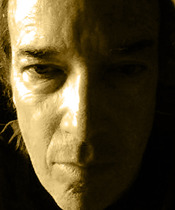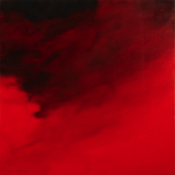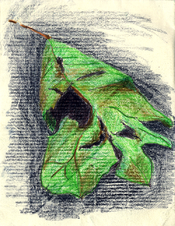Sunset, Tuesday, 1 September 2009
 William Theodore Van Doren. Stony Point, Albemarle County, Va. Oil on paper, 16 x 20.
William Theodore Van Doren. Stony Point, Albemarle County, Va. Oil on paper, 16 x 20.
I was very excited tonight to see, I think for the first time since this site started, a perfectly clear, ‘blank’ sky to work with. I’d been wondering what I’d do if I got one of these again; although this may not seem like much of a departure, it reflects development that’s been going on in the paintings for the past six weeks or so.
As soon as this painting was done, the sky went through a phenomenal series of twilight changes. The result was a deeply glowing old-gold horizon, a dome of intense blue-violet and, in between, a rose-violet aura that shimmered like Northern Lights. Yes, yes, I just may have to try to paint it tomorrow.
I’ve spent much of the day catching up with posts and images from Pittsburgh, and find myself not having thought of a single thing to say for tonight, so I’ll break style a bit and post some ‘home photos’ that each reprise aspects of the trip.
From the 27th, this is my Aunt Millie and me in her kitchen on her 90th birthday. In case you somehow can’t tell from the photo, Millie is a joy.
As reported on the 28th, we went up the Duquesne Incline – and here we’re at the top. The trio of yellow bridges that you can perhaps just make out on the Allegheny River, after the first yellow bridge, as mentioned on the 29th, are the Roberto Clemente, the Andy Warhol, and the Rachel Carson.
Finally, we’ve also discussed Pittsburgh (“SIXBURGH”) and football. Well, amazingly, everywhere we went, even at the top of the Duquesne Incline ...
... we spotted celebrity athletes with names like Hines Ward, Troy Polamalu, and Ben Roethlisberger. Fantastic!
 Tuesday, September 1, 2009 at 08:24PM | by
Tuesday, September 1, 2009 at 08:24PM | by  BVD | in
BVD | in  Sunset Paintings | tagged
Sunset Paintings | tagged  Andy Warhol,
Andy Warhol,  Aunt Millie,
Aunt Millie,  Ben Roethlisberger,
Ben Roethlisberger,  Blue Ridge,
Blue Ridge,  Duquesne Incline,
Duquesne Incline,  Hines Ward,
Hines Ward,  Laura Owen Sutherland,
Laura Owen Sutherland,  Rachel Carson,
Rachel Carson,  Roberto Clemente,
Roberto Clemente,  Sixburgh,
Sixburgh,  Troy Polamalu,
Troy Polamalu,  photography | | Comments Off
photography | | Comments Off 








